Too Hot To Handle
Posters on Climate Change, Pollution & Environmental Justice







was funded in part by the California Arts Council, the City of Los Angeles Department of Cultural Affairs, with additional support from Los Angeles County Arts Commission, the Multicultural Undergraduate Internship Program (Getty Foundation), and individual donors.


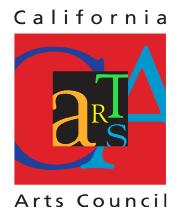

I. Early Environmental Awareness
II: Climate Change
III: Environmental Racism
IV: Profits Over People
V: Fossil Fuels
VI: Deforestation
VII. Pollution
VIII. Environmental Disasters
IX. Martyrs

1 Ecology Now Earth First Offset, Circa 1970 United States
April 22nd, now widely celebrated as Earth Day, marks the anniversary of the birth of the modern environmental movement. Gaylord Nelson, a U.S. Senator from Wisconsin, was outraged by the devastation he witnessed during a trip to Santa Barbara shortly after the massive 1969 oil spill. He proposed that every university campus in the U.S. hold a teach-in on the environment on April 22, 1970. His idea was modeled on the highly effective Viet Nam War teach-ins of the time, during which massive educational forums were held on university campuses to give the public a chance to learn about and discuss complicated political issues. Thousands of schools responded to Nelson’s call with organized protests, and on April 22, 1970, approximately 20 million Americans across the nation took to the streets to demonstrate for a healthy and sustainable environment. The Earth Day movement proved to be autonomous with no central governing body—not unlike the Occupy movement of today.
In 1993, Senator Nelson described how it simply grew on its own: “Earth Day worked because of the spontaneous response at the grassroots level. We had neither the time nor resources to organize 20 million demonstrators and the thousands of schools and local communities that participated. That was the remarkable thing about Earth Day. It organized itself.”
3 Remember…when the Air was Clean and Sex Dirty Paul B. Haglund, © E-Z Prod. Offset, Circa 1970s North Hollywood, CA
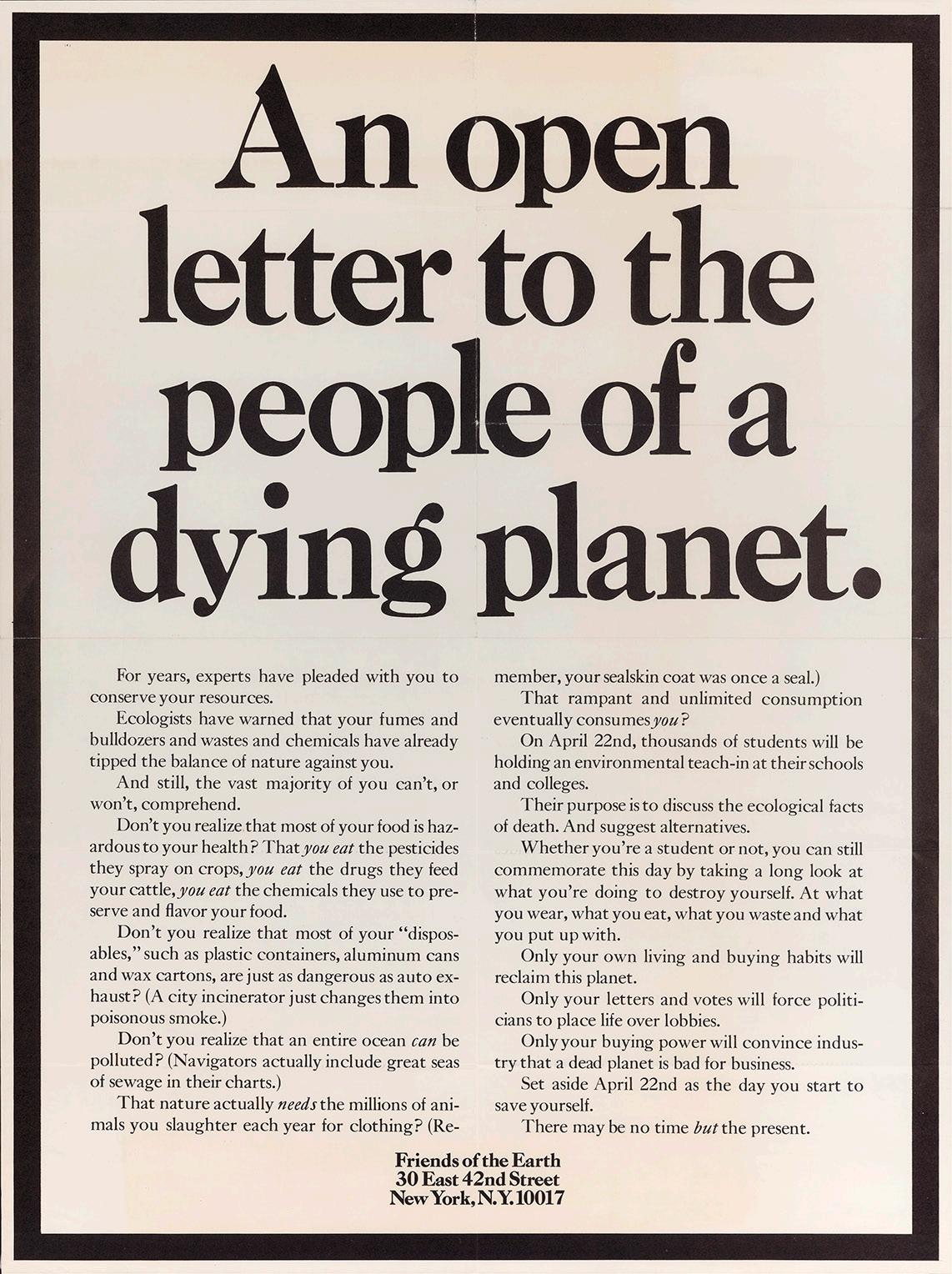
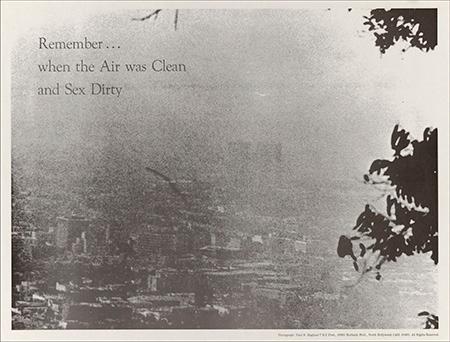

4 A Plea for Help in Stopping Pollution
American Civil Liberties Union of Southern California (ACLU) Offset, 1970
Los Angeles, CA
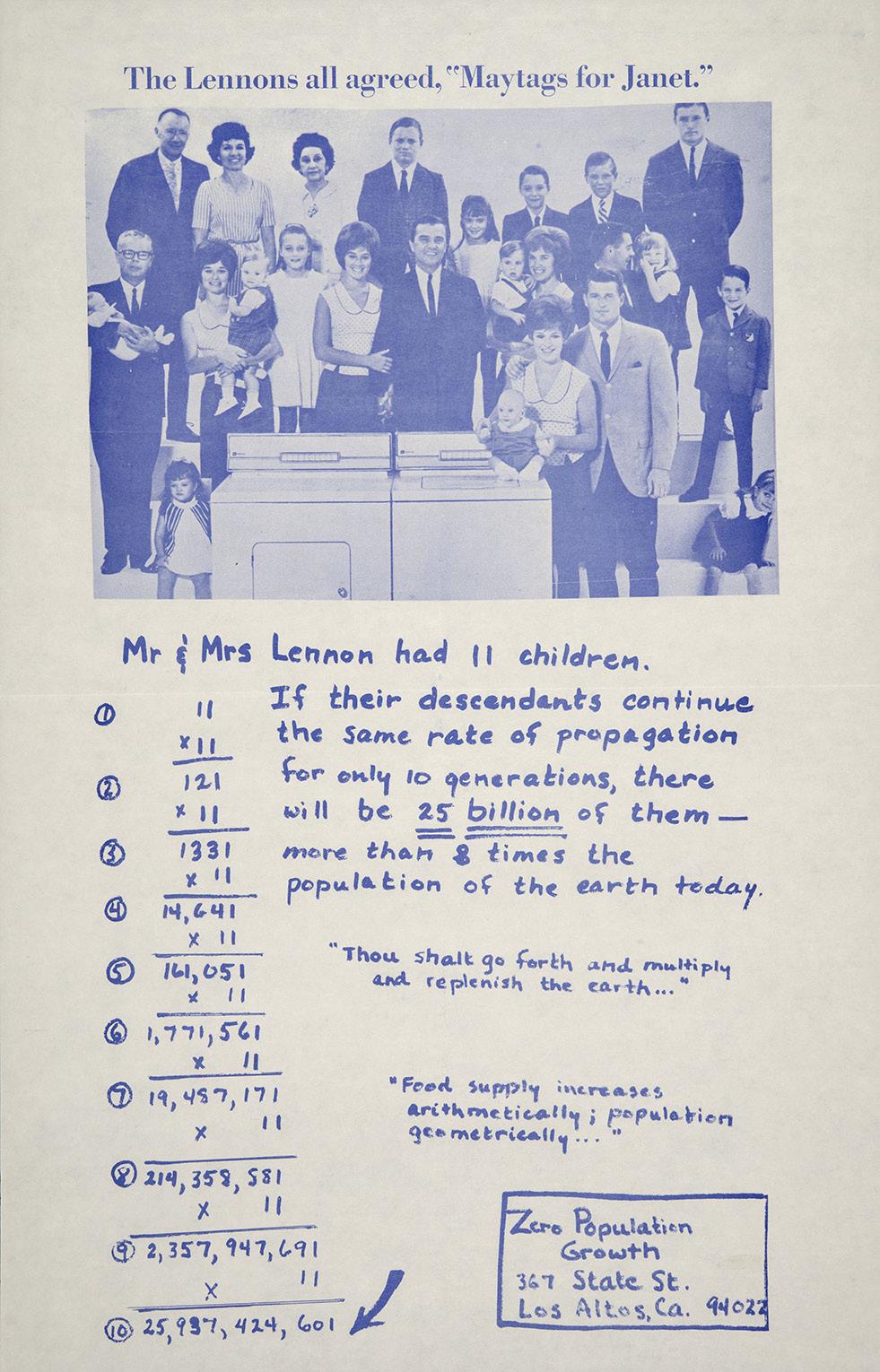
5 The Lennons all agreed, “Maytags for Janet” Zero Population Growth Offset, Circa 1970
Los Altos, CA
Many environmentalists argue for population control, asserting that population growth leads to an increase in production and waste, which in turn increases carbon dioxide emissions and contributes to climate change. These claims, however, wrongly emphasize growth in poor or third world populations that produce virtually no emissions at all because of their low rates of consumption. Rather than focusing on the weak correlation between global warming and population growth, the relationship between wealth and global warming should be examined.
Wealthy people living in highly developed countries use a disproportionate amount of the world’s resources. Thus, they contribute disproportionately to climate change. This poster appropriates a Maytag advertisement from 1968 that features Janet Lennon, member of the vocal quartet known as the Lennon Sisters, and her 11-sibling family. The original advertisement boasted that it was a Lennon family tradition for each sister to receive a Maytag washer and dryer set as a wedding gift. The poster, created by Zero Population Growth (which changed its name to Population Connection in 2002), questions the effect that large, consumer families such as the Lennons will have on the planet within a few generations.

6 Stop the US Ecocide in Indochina Swedish Committee for Vietnam Offset, Circa 1970 Sweden
During the war in Southeast Asia, the U.S. military sprayed more than 19 million gallons of Agent Orange—a powerful mixture of chemical herbicides including dioxin, a highly toxic carcinogen—across 10% of South Viet Nam, or over 4.5 million acres. Known as Operation Ranch Hand, the U.S. military’s large-scale defoliant program was aimed at destroying the forest and jungle cover in an attempt to expose guerrilla fighters of South Viet Nam’s National Liberation Front and soldiers from the North Vietnamese army who were fighting to reunite their country. From 1961 to 1972, U.S. aircraft sprayed Agent Orange and other powerful herbicides around roads, rivers, military bases, and on crops that might feed enemy troops. Agent Orange was later found to cause tumors, birth defects, cancer, and psychological issues in those exposed to the harmful herbicide, from Vietnamese civilians to U.S. veterans and their families.
Although this type of chemical warfare is now recognized as a violation of human rights, it continues today. In 2015, the Israel Defense Forces (IDF) admitted to spraying herbicides on over 420 acres of Palestinian land, much of which was used to grow agricultural crops such as spinach, peas, parsley, and beans, thus greatly limiting their food supply and livelihood.
In 2001, coalition members Greenpeace, Friends of the Earth, and People and Planet started a boycott campaign against the multinational oil company ESSO, known as ExxonMobil in the United States, because of the company’s greenhouse gas production and climate change policies. Esso was charged with denying that climate change is caused by the burning of fossil fuels, pouring money into efforts to derail international action on climate change, and refusing to invest in renewable energy sources. In 2002, Esso sued Greenpeace for its parody of the Esso logo, which replaces the two letters “S” for dollar signs. Although Esso initially won the suit, it was subsequently overturned and Greenpeace continues to use the E$$O parody.

7 Directed and Produced by E$$O ExxonMobil Greenpeace Four Offset posters, 2002 Luxembourg

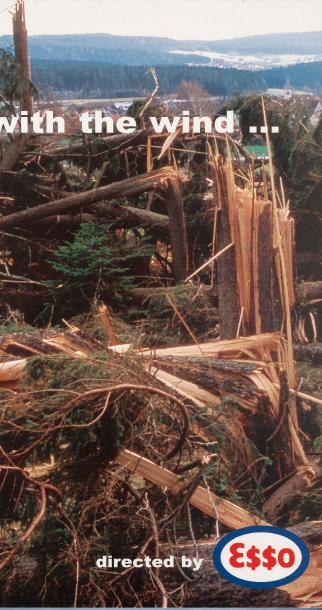



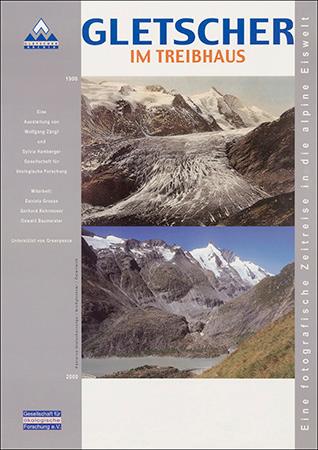
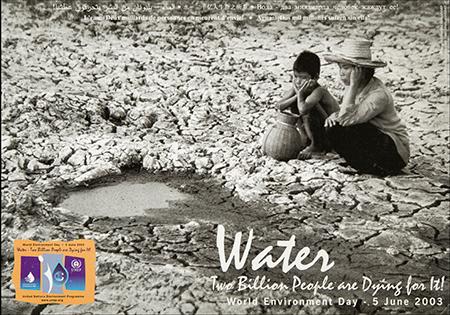
10 Water: Two Billion People are Dying for It!
by Somkiat Sirvikol Division of Communications and Public Information/UNEPOffset, Circa 2003 United Nations
Photo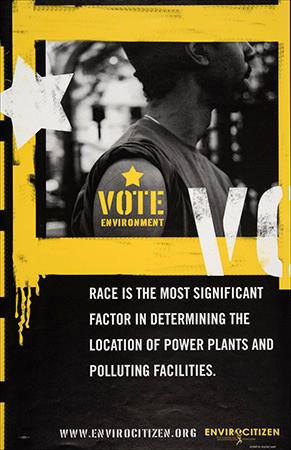
Vote Environment
Cara Cox, Social Impact Studios, The Center for Environmental Citizenship Offset, Circa 2004 Philadelphia, PA
12 Join the General Rent Strike
Seth Tobocman, Housing Solidarity Network Offset, Circa 1996 New York, NY
In the 1990s, the Housing Solidarity Network organized rent strikes in Harlem, a majority black neighborhood where thousands of tenants were facing threats of eviction. Many of these tenants lived in buildings owned by New York City’s Housing Preservation and Development (HPD). These units were often unsafe, violated city housing codes, and exposed tenants to hazardous lead paint, which can cause irreversible learning disabilities and behavioral issues in children. The rent strikes put pressure on the city government and saved the homes of thousands of people facing eviction.


13 ¿Dejaría a sus hijos jugar cerca de una planta eléctrica?
Would you let your children play near a power plant
Communities for a Better Environment Offset, Circa 2001 Los Angeles, CA
In 2000, L.A.-based Sunlaw Energy Partners began moving forward with a proposal to build a power plant in South Gate, CA. The plant was to be called Nueva Azalea as a nod towards the community’s largely Latino population as well as the official city flower. While the name Nueva Azalea [New Azalea] carries connotations of vibrancy and health, the power plant itself would only increase pollution in the small, working-class city that was already strained by two dozen statedesignated toxic sites.
Communities for a Better Environment (CBE), along with local community members, launched a successful, grassroots campaign to stop the power plant from being built. At the start of the campaign, many felt that it would be impossible to defeat the multi-million dollar corporation, which was spending hundreds of thousands of dollars to promote the plant through parades, festivals, and newspaper and television ads. The issue of whether the plant would be built was put on a ballot for the 2001 local elections. For months, CBE organized community education meetings, held marches from South Gate High School to City Hall, voiced opposition at public hearings, and held a solar powered festival in the park to demonstrate alternatives to fossil fuels. These educational and outreach efforts culminated in an election victory and the project was abandoned.
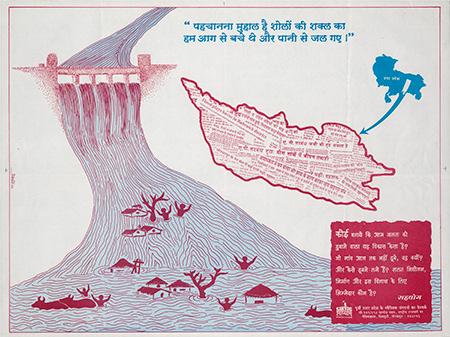
14 Who is Responsible for this Bad Planning?
Network of Voluntary Organizations of East Pradesh, Sahyog Khalid GKP
Offset, Circa late 20th century
It is hard to recognize the face of flames. We survived the fire but we got burnt by the water. Someone please tell us what is the use of development that would drown normal people? The villages that haven’t drowned till now, why that? And how are they drowning it? Who is responsible for this wrong move in construction and development?
cusecs after ten days of persistent rain. The walls of the dam began to weaken and eventually collapsed, causing waves up to 30 feet high to sweep over the surrounding area. It is estimated that anywhere between 5,000 and 10,000 people were killed.
Because many dams continue operating past their intended lifespan, dam failure is not uncommon. One of the worst dam disasters in history occurred in 1979 at the 2.5-mile long Machchu dam, located near the small town of Morvi in Gujarat, India. The dam’s floodgates had been wrongly designed for passage of 220,000 cubic feet of water per second (cusecs) and received a flow of 400,000
In the past few decades, anti-dam movements have gained momentum throughout the world, including in India, where the building of dams has caused massive displacement among indigenous and poor populations. Dams have also been criticized for their environmental degradation; they block the movement of fish and other species and often change the ecosystem from that of a river to that of a pond, destroying the natural community of plants and animals.
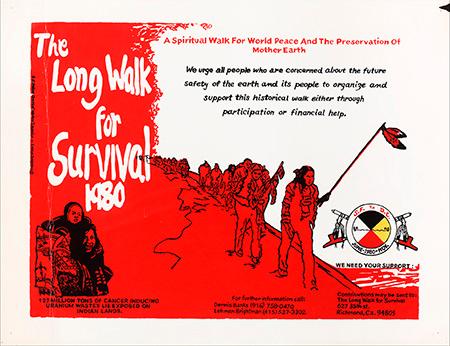
15 The Long Walk for Survival 1980
S.F. Indian Center “Watha” Graphics
Silkscreen, Circa 1980
San Francisco, CA
The Long Walk for Survival was a 3,500 mile trek across the United States that began on June 1, 1980, and was led by Native Americans representatives of over 80 different tribes. Over a five month period, approximately 430 people marched from California to Washington D.C. to demand an end to nuclear development, the forced sterilization of indigenous women, the military draft, and uranium mining on native land.
At the time, about 55% of U.S. uranium mines were located on Indian reservations,
exposing local communities to radioactive waste that causes cancer and birth defects. It was also discovered that about 40 to 50 percent of Native American women had been sterilized without their consent. This mass sterilization, coupled with the toxic conditions of the reservations, was compromising the native people’s autonomy and contributing to their genocide. The Long Walk for Survival demanded an end to the violence and war inflicted on both the native people and the Earth and sought to create a shift towards stronger spirituality and respect.
People Not Pozos is an environmental justice campaign that advocates for the health and safety of communities impacted by oil and natural gas extraction. For years, residents of University Park in South Los Angeles, were exposed to the noxious emissions from an oil drilling site operating dangerously close to homes, schools, playgrounds, and churches. People Not Pozos was launched as a direct response to the concerns raised by residents, and it is now a communityled campaign that empowers, informs, and mobilizes communities to combat neighborhood drilling.
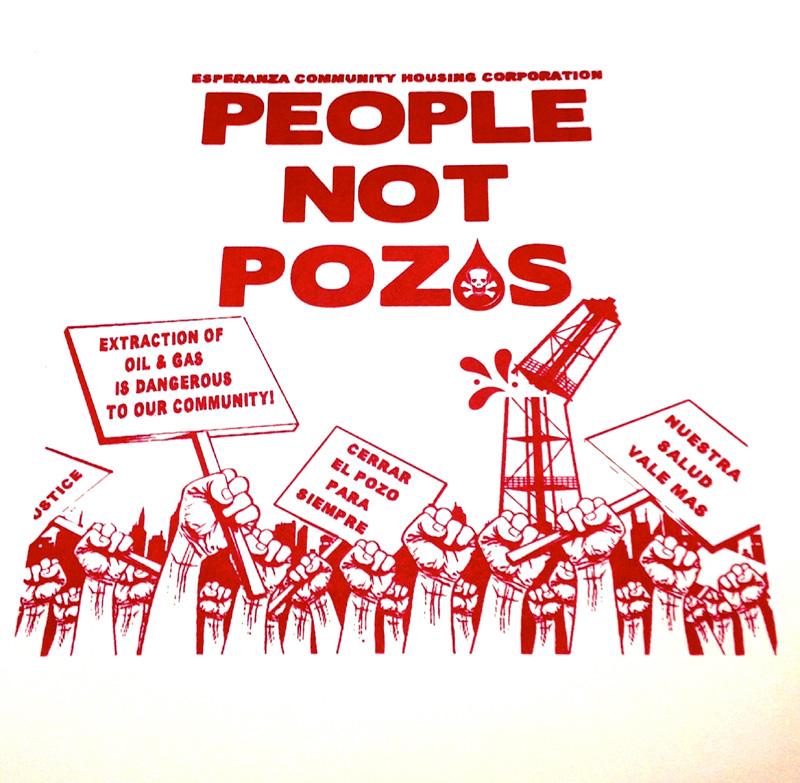
Angelica Romero, Esperanza Community Housing Corporation Silkscreen, Circa 2013 Los Angeles, CA
In 2000, Exide Technologies purchased a battery recycling plant that had operated since 1922 in Vernon, California. The plant operated around the clock seven days a week, crushing, melting, and processing car and truck batteries to extract metal lead to create new batteries. In 2013, residents of the low-income Latino communities around the facility learned that the plant had been spewing lead and arsenic emissions into their neighborhoods for decades; it was also found that the state agency responsible for overseeing the plant had never demanded that Exide meet all the requirements for a full permit. Outraged community members and environmental justice groups in East and Southeast Los Angeles demanded that the plant be shut down and that the soil

Wendy Gutschow for the University of Southern California, Southern CA Environmental Health Sciences Center in collaboration with East Yard Communities for Environmental Justice Digital print, 2016 Los Angeles, CA
(continue onto next page)
around their homes be tested. In March 2015, Exide signed an agreement with the U.S. attorney’s office to close the plant permanently in exchange for avoiding prosecution for years of environmental crimes. After testing the soil, state officials found lead contamination as far as 1.7 miles away from the plant, meaning that up to 10,000 homes were affected. Lead has been found to cause learning disabilities and other behavioral problems in children, even at low levels. The arsenic that the plant had emitted into the air also posed an increased cancer risk to 100,000 residents.
Community advocates continue to fight for faster action to clean up the contamination, which may take several years and tens
to hundreds of millions of dollars. USC’s Community Outreach and Engagement Program developed this poster and East Yard Communities for Environmental Justice created the hashtag #NoMoPlomo to continue raising awareness.
Flint, 2014

18 EPA Regulation
NancyOhanian Digital print, Circa 2016
Mantua, NJ
In April 2014, Flint, Michigan switched the city's water source to the long polluted Flint River to save money. Flint's majority low-income and black residents repeatedly reported a strange taste, smell, and appearance in their water, but their complaints were ignored for almost two years. In January 2016, the city was declared to be in a state of emergency after tests revealed high levels of lead in Flint's tap water.
E-mails later revealed that the state administration had known about Flint's contaminated water and had been shipping clean water for state employees a year before the state of emergency was declared. Many members of Flint's disenfranchised population
(continue onto next page)
had no choice but to continue drinking and bathing in the contaminated water despite their legitimate fears about its safety. A September 2015 study found that the number of infants and children with above-average levels of lead in their blood had doubled since the city first switched its water source to the Flint River. Between 6,000 and 12,000 children in Flint have been exposed to drinking water with high levels of lead and may experience a range of serious health problems.
In April 2016, criminal charges were filed by the Michigan Attorney General against three people in regards to the crisis. In addition, a $220 million damage claim was filed against the Environmental Protection Agency (EPA) for neglecting to warn Flint residents about widespread lead contamination. Michigan Governor Rick Snyder remains in office despite continuing calls for his resignation.

19 Mothers of East Los Angeles
Jen Cartwright, Celebrate People’s History Poster Series/Justseeds.org
Offset, Circa 2004
Design: Nashville, TN
Printing: Portland, OR
Project: Chicago, IL
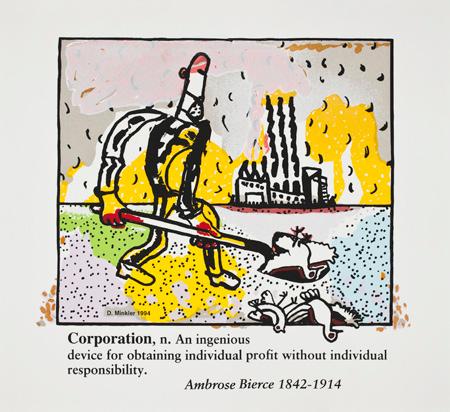

The practices and policies of multinational corporations often prioritize profit over the health of people and the environment. For example, giant agribusiness firms, which overlook the production and distribution of agricultural goods, claim that genetically modified organisms (GMOS) are safe and beneficial. GMOs are living organisms whose genetic material has been manipulated in a laboratory through genetic engineering. GMOs can increase a crop’s tolerance to pests and herbicides, meaning that there is a larger crop yield and thus, a larger
profit. More pesticides and herbicides are also used. Despite evidence that shows that GMOs harm people and the environment, it is in the economic interest of corporations to insist that GMOs are perfectly safe. These corporations are often so powerful that they influence policy around environmental issues. In the European Union, food containing GMOs must be identified on the labels. This is not the case in the U.S. and Canada, where millions of people are unaware of what they are consuming.
In 1993, the Rainforest Action Network (RAN) launched a boycott against the Mitsubishi Corporation for its role as one of the world’s leading destroyers of rainforests in an attempt to change the multinational corporation’s practices. Japan, where Mitsubishi is based, had been the world’s largest importer of tropical timber for over twenty years and Mitsubishi was its largest supplier. RAN’s ultimate goal was to establish standards for the conduct of large businesses and to hold powerful corporations accountable for their use of the planet’s resources. RAN’s campaign consisted of a boycott as well as letter writing, petitioning, and civil disobedience. In 1998, RAN ended its boycott against Mitsubishi when the corporation agreed to adopt a more sustainable environmental policy. Mitsubishi pledged to begin using paper and cardboard derived from non-tree sources such as rice and corn husk and begin financing forestry research.
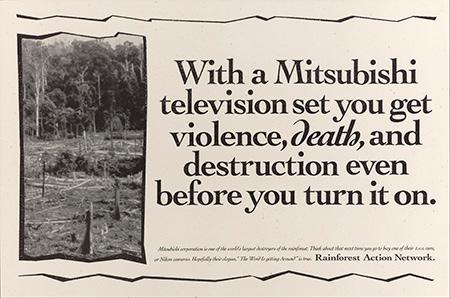
22 With a Mitsubishi Television Set
Rainforest Action Network
Offset, Circa 1990s
San Francisco, CA
Gulf Oil was the largest U.S. investor in Portuguese Africa*, and Harvard University was Gulf’s largest university investor. In 1972, a shareholder proposal asked Gulf Oil to report on its ties to the Portuguese government then ruling Angola, charging that the company’s presence in Angola lent support to a repressive and undemocratic regime. Harvard’s 700,000 shares of Gulf stock quickly became a hot topic on campus. The Pan-African Liberation Committee, Radcliffe African and Afro-American Association of Students, Harvard Black Faculty and Administrator’s Association, demanded that Harvard divest of its holdings in Gulf Oil. When Harvard President-elect Derek
Bok announced that the University would abstain from the vote, 25 student members of Afro and the Pan-African Liberation Committee occupied his office for a week in protest. In response, Bok dispatched Farber to Angola to gather first-hand information to help the University make future decisions. This poster was produced during these protests.
Although Harvard did not divest at this time, by the end of the ‘80s, Harvard was almost completely out of South Africa.
* Until 1975, Portugal had five colonies in Africa: Angola/Cape Verde/ Guinea Bissau/ Mozambique/Sao Tome & Principe.

Boycott Gulf
Photo: B. Adjali
Pan-African Liberation Committee
Offset, Circa 1972
Brookline, MA
The North American Free Trade Agreement (NAFTA), signed into law in 1994, sought to eliminate barriers to trade and investment between Canada, the U.S., and Mexico. After the establishment of NAFTA, hundreds of thousands of U.S. jobs were lost as corporations sought to exploit lower-wage workers in Mexico. In Mexico, NAFTA lowered wages, generated poverty, and forced millions to migrate north to the U.S. By prioritizing the rights of corporations over those of people in the name of free trade, NAFTA also greatly increased deforestation and pollution.
The Trans-Pacific Partnership (TPP) is a free trade agreement currently being negotiated by the U.S. and eleven other countries. Like NAFTA, TPP allows multinational corporations to challenge environmental policies that interfere with their profit and encourages dependence on fossil fuels, but on a much a larger scale.

24 Stop TPP – NAFTA on Steroids Artist unknown Digital print, Circa 2012 stoptpp.org/artandflyers
Water for All Not for Profit!
Access to safe drinking water is a basic human right. Privatization turns water into a commodity, which makes access to water a privilege to be purchased. Privatization of water is taking place throughout the world and in the United States. People are unknowingly advancing the privatization of water whenever they purchase water bottled by corporations such as Coca Cola (Dasani), Nestlé (Perrier, San Pellegrino, Acqua Panna and Poland Spring), Pepsi (Aquafina), Fiji Water, and many more. Failure to maintain the water infrastructure has caused many municipalities to sell their public water systems to private corporations—much to their regret.
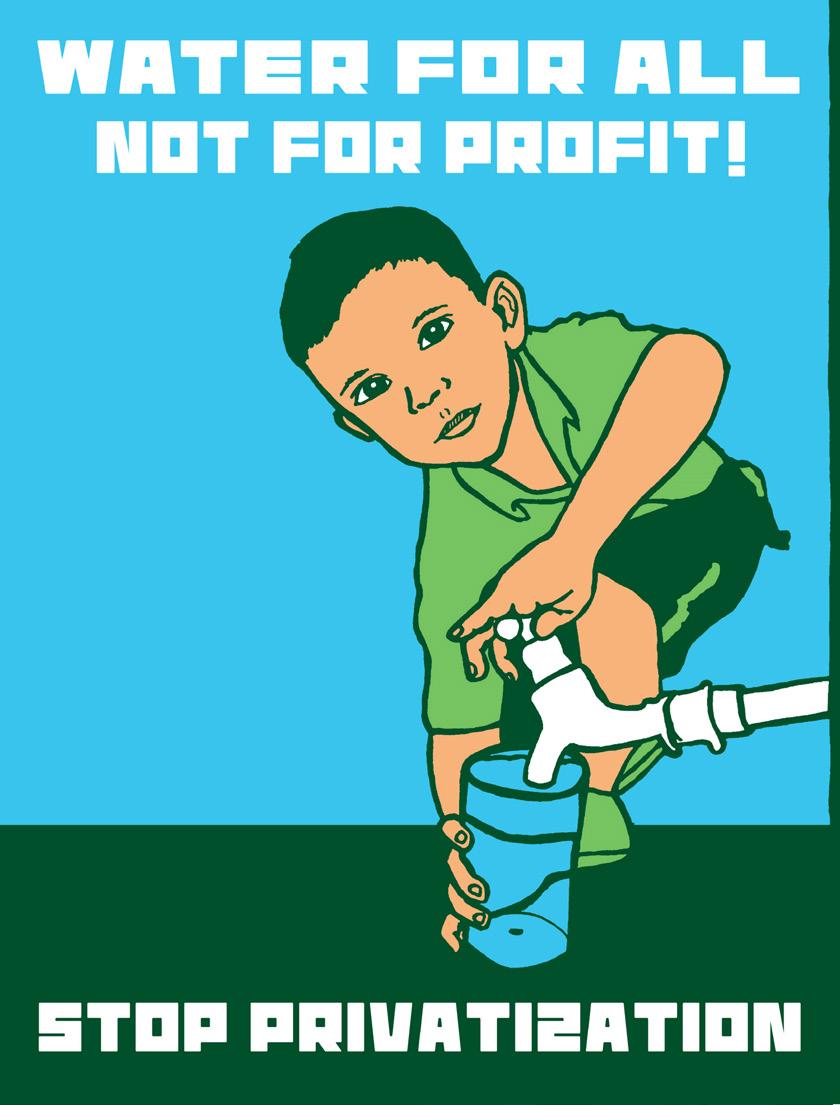
26 Water for All Not for Profit! Melanie Cervantes Silkscreen, Circa 2008 Oakland, CA
Fossil fuels include coal, gas, and petroleum that have been formed over millions of years using the remains of living organisms. Although formed naturally over time, these fuels ultimately contribute a negative effect to the world’s biosphere by releasing carbon dioxide that contributes to global warming. Fossil fuels currently supply the majority of the planet’s energy and more than two-thirds of the electricity produced in the U.S. Because they take so long to form, they are considered a nonrenewable resource.
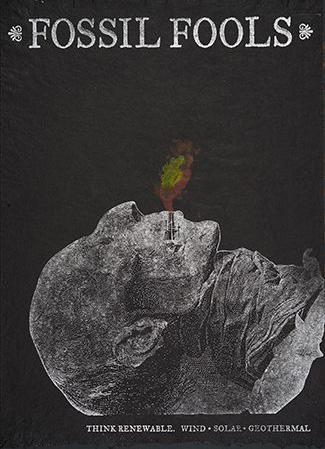
Bill Moran Letterpress, Circa 2004 St. Paul, MN
27 Fossil Fools
Oil Futures
Mariona Barkus
Offset, Circa 2013
Los Angeles, CA
Crude Reality
Sam Newbury, Chuck Sperry, Ron Donovan, Firehouse & Mission Print
Photographer: Timothy Greenfield-Sanders
Silkscreen, Circa 2008
San Francisco, CA
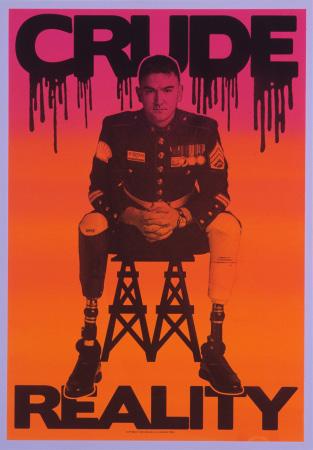
The poster depicts a double-amputee soldier wearing his medals while sitting on a stool that resembles a pair of oil derricks. The artist described it as a critique of the wars the U.S. and Britain have been fighting in Iraq and Afghanistan. The title refers both to the crude oil the wars were fought for, and the crude price this soldier and many others paid.

30 UNOCAL: Stop Sacrificing Women for Oil
Feminist Majority Foundation
Digital Print, Circa 1998
Los Angeles, CA
When the fundamentalist Islamic Taliban seized control of Afghanistan in 1996, women and girls were forbidden to work outside the home or attend school. Women were also forced to wear the Burka, which completely covered them from head to foot. Those who defied these orders were reportedly shot or stoned.
rights to build an oil pipeline through Afghanistan. Representatives from the Feminist Majority Foundation and other women’s rights organizations protested outside UNOCAL's annual shareholders meeting in California.
In 1998, women's rights organizations accused UNOCAL, a U.S. oil company, of entering into a business partnership with the Taliban government despite its record of human rights abuses against women and girls. UNOCAL and the U.S. government were attempting to secure
Ironically, the plight of women under the Taliban regime provided the United States with a convenient moral justification for its invasion of Afghanistan just three years later. "The fight against terrorism is also a fight for the rights and dignity of women," Laura Bush, wife of former President George W. Bush, said after the 2001 invasion.
Mountaintop removal is a type of coal mining that began in the Appalachia in the 1970s. As the name implies, this type of mining removes at least 500 feet off the tops of mountains in order to expose seams of coal underneath, often requiring the use of millions of pounds of explosives. These explosions are so strong that they can crack the foundations and walls of nearby homes, and the removal process often dries up or contaminates water wells used by local communities.
The poster shows the late Larry Gibson, a longtime environmental activist who dedicated his life to fighting against mountaintop removal mining in West Virginia, specifically at Kayford Mountain, where he was raised. Gibson often travelled the country raising awareness about the dangers of mountaintop removal and how the community he had known as a child had been destroyed by the coal industry.
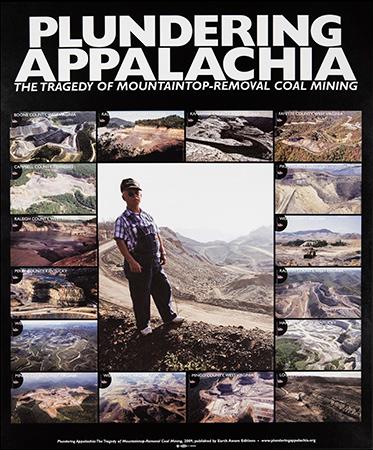
Douglas Tompkins, Kevin Cross, Earth Aware Editions Offset, Circa 2009 Berkeley, CA

32 Not for Consumption
Molly Fair, Jesse Goldstein, Justseeds Offset, Circa 2011 Brooklyn, NY
Hydraulic fracturing, or fracking, is the process of pumping water, sand, and chemicals into the ground at high pressure in order to fracture shale rock and release difficult-to-reach natural gas. Although fracking has been marketed as a safer alternative to foreign oil and other fossil fuels, fracking can cause major environmental problems. Groundwater can become contaminated with the over 600 chemicals used in fracking fluid, directly exposing people and livestock to known toxins and carcinogens. It also uses huge amounts of water; each fracking job requires 1-8 million gallons of water, which must be transported using an average of 400 tanker trucks per fracking site.
33 Our Arctic Way of Life has Endured for 20,000 Years …
Taro Yamasaki, Jim Brandenburg, Karen Jettmar
Offset, Circa late 1990s
Anchorage, AK
34 Stop the Pipeline Design Action Collective Offset, Circa 2011 Oakland, CA
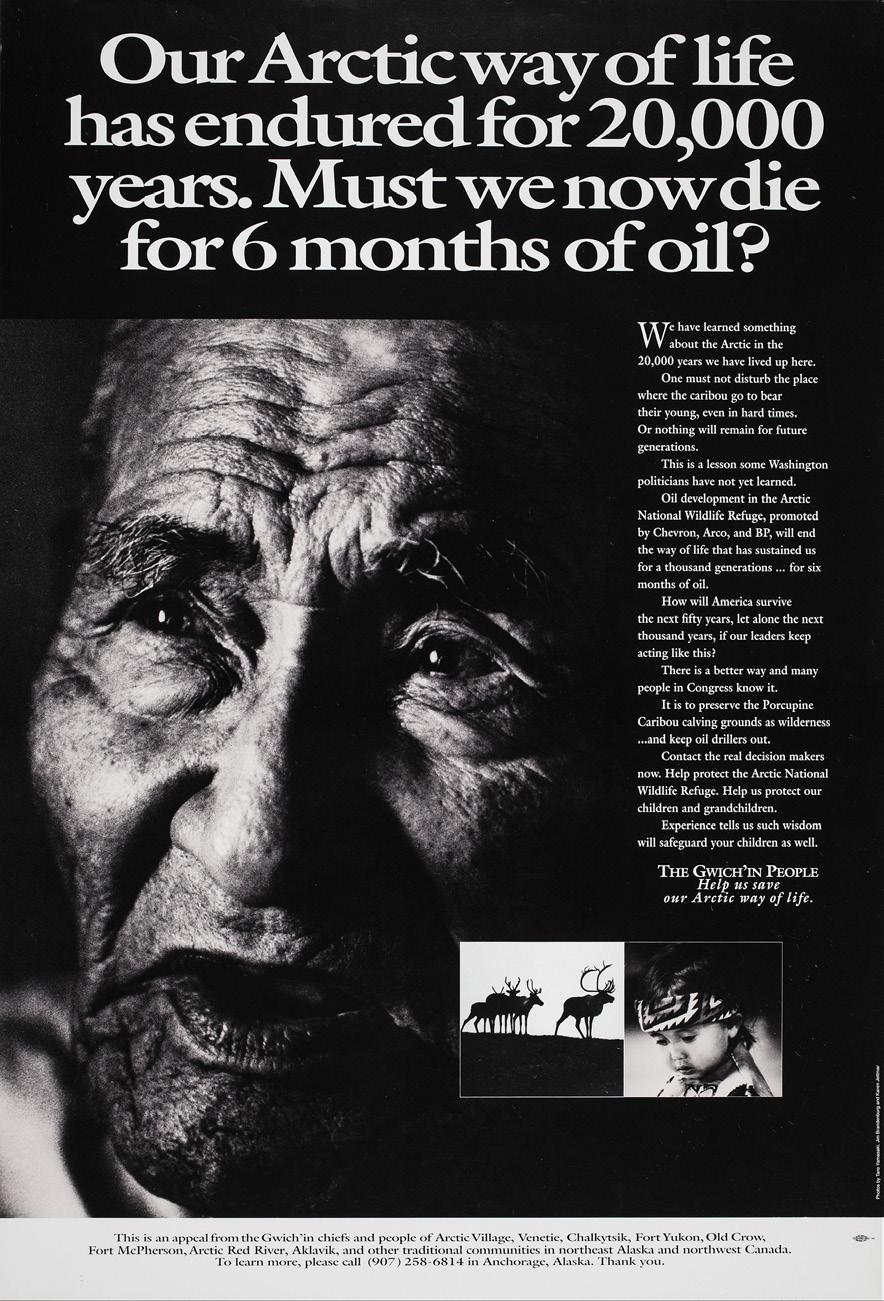
JOIN THE TAR SANDS SIT-IN AT THE WHITE HOUSE AUGUST 2011 tarsandsaction.org
Tar sands oil, a mixture of sand, clay, water, and tar, is the dirtiest and most climate-destructive form of oil in the world. When it spills, it is almost impossible to clean up. The Keystone Pipeline System is a Canadian-U.S. pipeline to transport oil from tar sands in Alberta, Canada to sites in Illinois, Oklahoma, and Texas. Oil derived from tar sands has historically been considered an unconventional and expensive source of petroleum but is now being refined and used by oil companies. The pipeline has been criticized for undermining efforts to slow climate change by investing in the use of fossil fuels.
Commissioned in 2010, the pipeline has completed three of four phases included in the project proposal. The fourth phase is another pipeline, known as Keystone XL, which would have the same origin and destination as Keystone but would take a more direct route and carry an increased supply of oil. Keystone XL was met with strong opposition by environmentalists and was ultimately voted down by Obama’s administration after six years of review.

35 The Cycle of Poverty
One World Campaign Offset, Circa 1996
Australia
36 Your Taxes Pay for the Destruction of Your National Forests
Gary Braasch: Photo ©1992
Mary Macenka: Design Light Hawk Offset, Circa 1992
Santa Fe, NM

Through its timber sale program, the United States Forest Service allows private timber companies to cut down trees on public land, including national forests. Because of the money that Forest Service spends preparing and administering timber sales or repairing ecological damage, commercial logging in national forests ends up costing taxpayers hundreds of millions of dollars a year. Environmentalists argue that the timber sale program is not only subsidizing the sale of taxpayer-owned resources but is destroying the environment as well. Many logging companies use a technique known as “clearcutting” in which most or all of the trees in a selected area are cut down at once. Clearcutting compromises the biodiversity of our national forests and also damages water and soil quality as well.



37 ¿Y tú, te lavarás las manos como Poncius Pilatus? And you, will you wash your hands like Pontius Pilate?
CESTA, Friends of the Earth Offset, Circa 1990s El Salvador
38 Let us Protect the Balance of Nature, Save the Homeland Nepal Australia Community Forestry Project Offset, Date Unknown Nepal
Deforestation has destructive impacts on biodiversity and accounts for a fifth of the world’s greenhouse gas emissions, making it a major contributor to climate change. In an attempt to reduce deforestation, the UN proposed Reducing Emissions from Deforestation and Degradation (REDD). REDD is a framework that gives monetary awards to countries that are not destroying their forests for profit as a financial incentive.
Many forest-dependent indigenous communities object to REDD as a form of colonialism because it takes land and resource rights away from these groups. REDD increases political marginalization already faced by indigenous people by denying them the right to participate in the program’s financial benefits. Countries participating in REDD programs are not adhering to international law, which requires that indigenous people give free, prior, and informed consent to decisions that affect their land and livelihood.

Mazatl, Melanie Cervantes, Justseeds
Digital print, Circa 2011
San Cristobal de las Casas, Mexico
Design: San Leandro, CA
40 Your Move!
S. Prikaschikov, Edited: I. Pilischenko, Y.Kurova, Plakat, Socialistic Harkivschina
Offset, Circa 1989
Moscow

 41 Pollution Kills
41 Pollution Kills

Acid Rain Plagues U.S.
Mariona Barkus Offset, Circa 1982
Los Angeles, CA
Acid rain is rainfall made toxic by atmospheric pollution. Acid rain is mainly caused by the burning of fossil fuels, which releases sulfur and nitrogen oxide into the atmosphere. These emissions then mix with water, oxygen, and other chemicals to form sulfuric and nitric acids that fall to the ground in rain, snow, fog, or hail.
By studying layers of glacial ice it has been discovered that the onset of the industrial revolution has resulted in a large increase in acid rain production. Electricity generation, factories, and motor vehicles are the largest exporters of these harmful emissions. When acid rain falls back onto the earth, it directly harms vegetation, animals, and even buildings and structures.
44 Take a Deep Breath
Tim Mendhall, EarthShare Offset, Circa 1991
Los Angeles, CA
45 Join the People of Detroit Design Action Collective Offset, Circa 2010 Oakland, CA
46 Stop Pesticides Use
Anna Fer, Pesticide Action Network (PAN) Asia and the Pacific Offset, Circa 1980s Penang, Malaysia
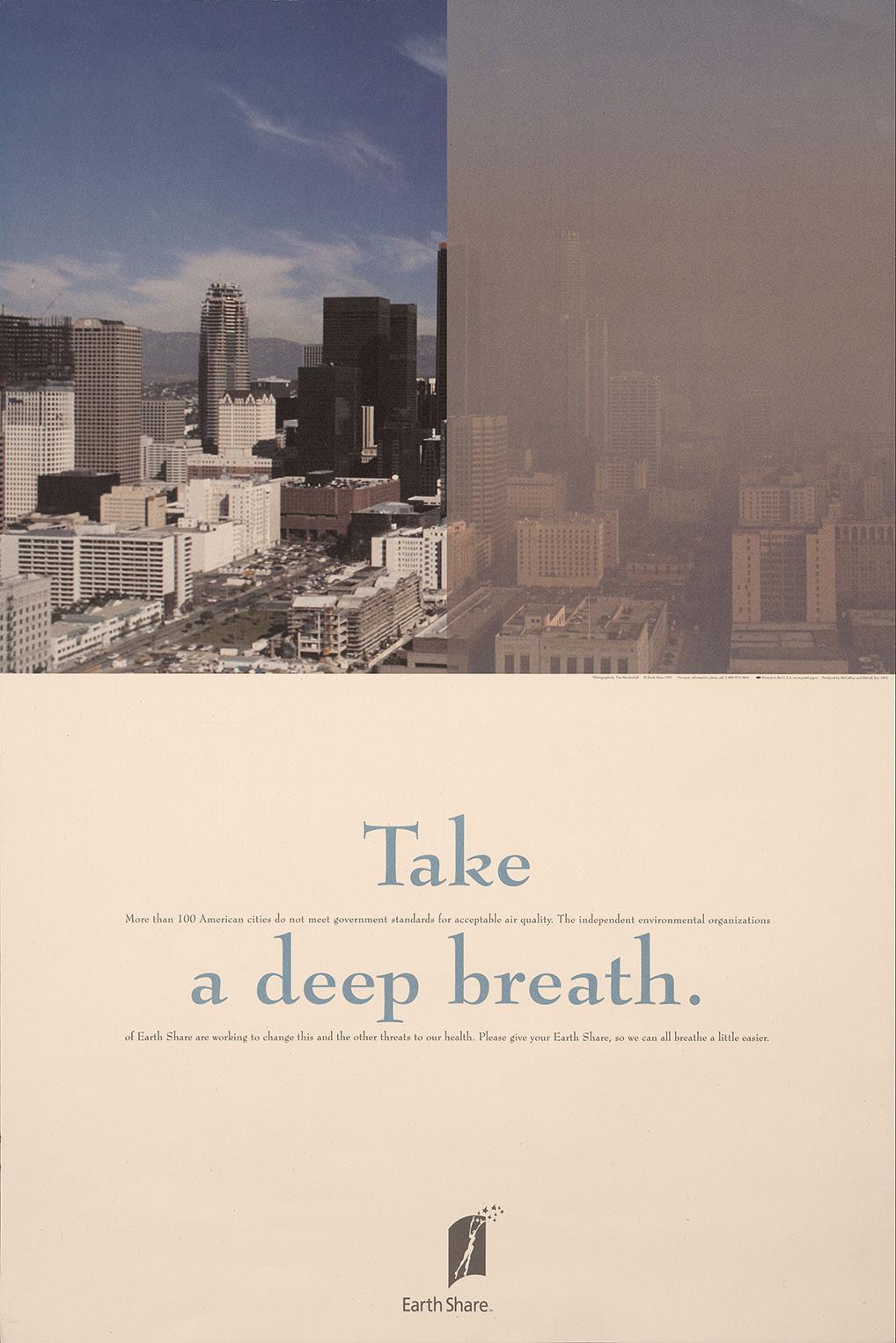

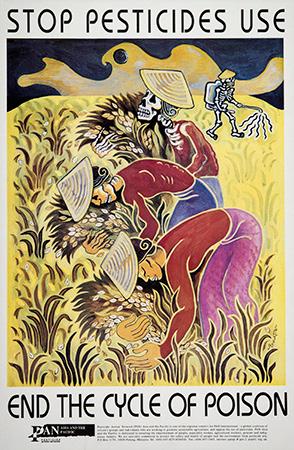
47 Circle Of Poison
Doug Minkler; Pesticide Education and Action Project
Silkscreen, Circa 1986
San Francisco, CA
48 Missing
ABCNT
Digital print, Circa 2011
Los Angeles, CA
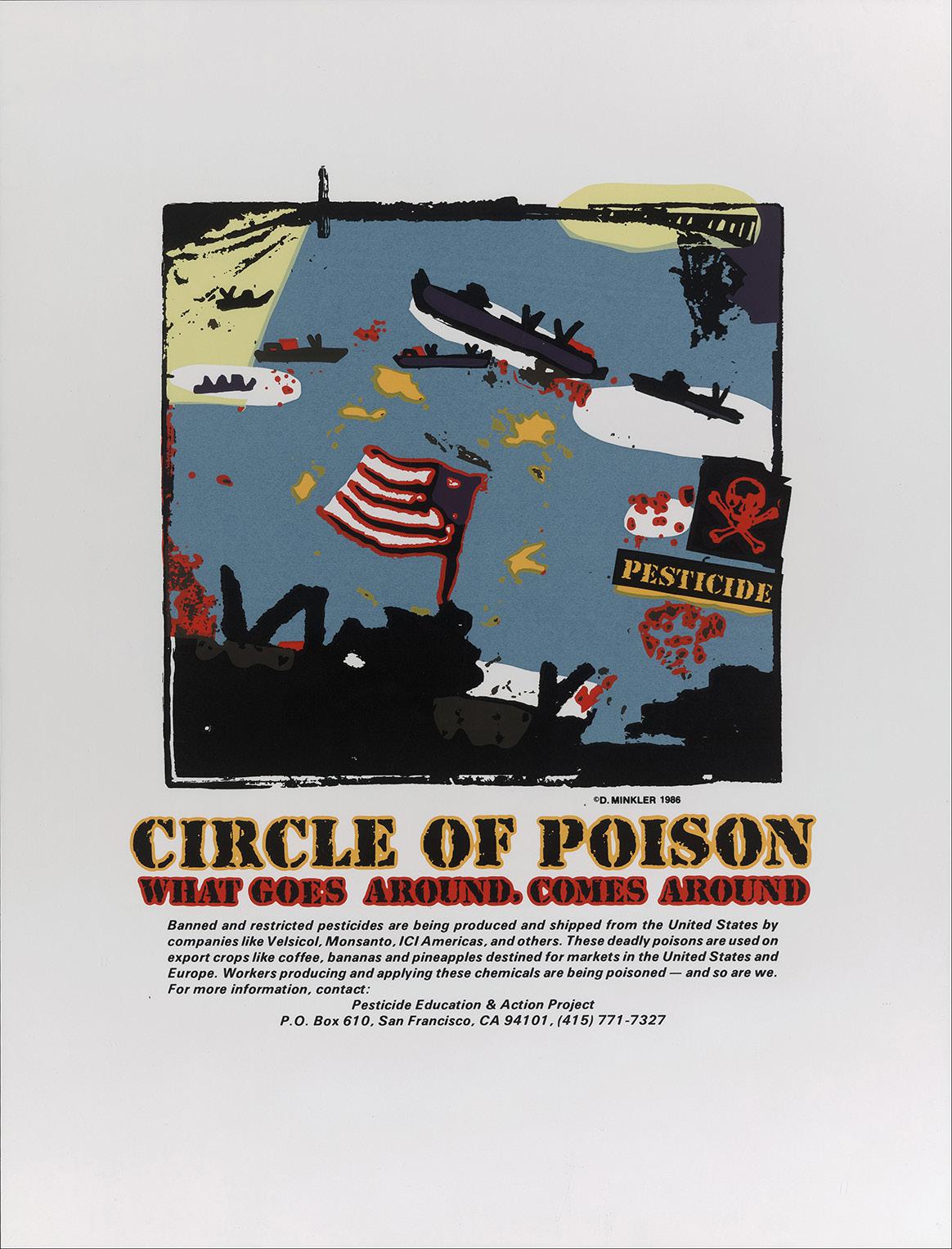

For years beekeepers have been noticing higherthan-usual colony losses, with 20 to 40% of their bees mysteriously disappearing after each winter. These losses have been called Colony Collapse Disorder (CCD). In cases of CCD, adult bees disappear from the colonies and leave behind the honey, pollen, and a queen. No dead bees are found inside or outside the colony; they simply disappear.
Bees play a critical role in maintaining the world’s food supply; they pollinate 70 of the 100 crop species that feed 90% of the world. The loss of bees at alarming rates is a life-or-death situation for humans, who depend on these pollinators for food. Researchers believe that CCD may be caused by a number of interwoven factors, such as climate change, pesticide use, habitat loss brought about by human development, and the electromagnetic waves emitted from cell phones.
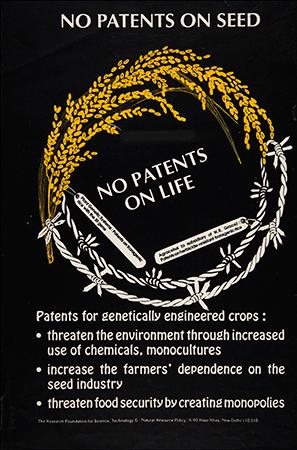
49 No Patents on Seed
The Research Foundation for Science, Technology, & Natural Resource Policy Offset, Date Unknown
New Delhi, India

50 No al Maíz Transgénico No Genetically Modifed Corn La Via Campesina Offset, Date Unknown Mexico
Globalize the struggle, globalize hope! NO genetically modified corn
1. Prohibit the experimental planting and commercial cultivation of genetically modified corn in Mexico.
2. Declare the 59 species and thousands of variations of native and creole corn a continuing heritage of diversity and improvement by indigenous people and farm workers in service to the people of the world.
3. Stop importing genetically modified corn.
4. Ensure that corn seeds sold commercially are not genetically modified.
5. Repeal the Biosafety and Genetically Modified Organisms Law.
6. Repeal the federal Seed Production, Certification, and Trade Law.
7. Give constitutional status to Food Sovereignty Food sovereignty NOW!
Genetically Modified Organisms, or GMOs, are living organisms whose genetic material has been manipulated in a laboratory through genetic engineering. This can create unstable combinations of plant, animal, bacterial and viral genes that do not occur in nature. Critics of GMOs state that genetic modification can raise unforeseen issues in the health of humans; they have been linked to toxic and allergic reactions as wells as damage to organs. Because GMOs increase a crop’s tolerance to pesticides, toxic pesticides are now directly sprayed onto the plants. Lastly, the use of GMOs increasingly puts agriculture under the control of biotechnology corporations whose primary motivation is profit, not health.

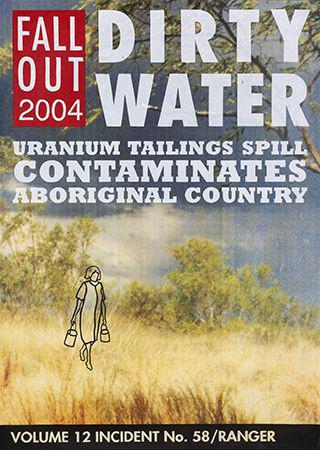
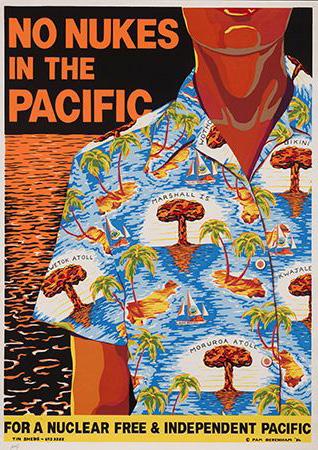
53 No Nukes in the Pacific
© Pam Debenham, Tin Sheds, University of Sydney Art Workshop
Reproduction of Screenprint, Circa 1984 Sydney, Australia
Between 1945 and 1992, the United States tested 1,032 nuclear bombs. Most of these tests took place either at the Nevada Testing Site, where over 900 were conducted, or at the Pacific Proving Grounds in the Marshall Islands. The U.S. conducted 105 atmospheric and underwater nuclear tests in the Pacific with extremely high yields, with yield referring to the amount of energy released during detonation. Although the bombs dropped at Marshall Islands made up only 14% of the U.S.’s tests, they composed 80% of the total yields of U.S. nuclear bombs.
Since the Gulf War, the U.S. military has been using tank armor and bullets made with depleted uranium (DU) on a large-scale because of its armor-piercing density. Weapons that contain DU can contaminate the environment with dangerous levels of DU dust and debris, which can then be spread by water or air into food and water supplies.
Although DU is only 60% as radioactive as natural uranium, its chemical toxicity is about the same as that of lead and can cause harm to internal organs. Long-term effects of exposure to DU include cancer, chronic fatigue syndrome, joint and muscle pain, rashes, neurological damage, mood disturbances, infections, vision problems, lung and kidney damage, and severe skin conditions.

54 Warning: Smoking the Enemy Artist unknown
Photocopy, Circa 2001
Los Angeles, CA
Barbara Oil Spill, 1969
This poster was produced in response to the Santa Barbara oil spill which occurred in January and February 1969 in the Santa Barbara Channel. It was the largest oil spill in United States waters at the time, and now ranks third after the 2010 Deepwater Horizon and 1989 Exxon Valdez spills. Within a ten-day period, an estimated 80,000 to 100,000 barrels of crude oil spilled into the Channel and onto the beaches of Santa Barbara County in Southern California, fouling the coastline from Goleta to Ventura as well as the northern shores of the four northern Channel Islands. The spill had a significant impact on marine life in the Channel, killing thousands of sea birds, as well as marine animals such as dolphins, elephant seals, and sea lions. The aftermath of the spill inspired thenSenator Gaylord Nelson of Wisconsin to organize what came to be known as “Earth Day,” when he succeeded in amassing some 20 million people to the cause of educating people on issues related to the environment on April 22, 1970. The public outrage engendered by the spill resulted in numerous pieces of environmental legislation within the next several years, legislation that forms the legal and regulatory framework for the modern environmental movement in the U.S.
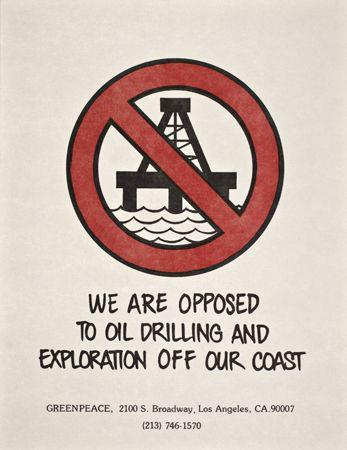
55 We Are Opposed To Oil Drilling...
Greenpeace Offset, Circa 1970
Los Angeles, CA
Robert Cenedella’s poster appropriates Christina’s World, a famous painting created by Andrew Wyeth in 1948. The woman in the original painting is Anna Christina Olson, who suffered from a degenerative muscular disorder that prevented her from walking. The poster replaces the house and barnyard in the original painting with the infamous Three Mile Island Nuclear Generating Station located near Harrisburg, Pennsylvania. The plant became famous following a partial nuclear meltdown in 1979, when a combination of technical failure and human error caused a reactor valve to malfunction and release radioactive material into the surrounding area. Massive demonstrations were organized by anti-nuclear activists following the fallout, and over 200,000 people attended a rally in New York City. By the mid-80s, construction of nuclear plants had slowed down dramatically in the U.S. and stricter nuclear regulations were put into place.

56 We All Live in Harrisburg
Robert Cenedella Lithograph, Circa 1979
New York, NY

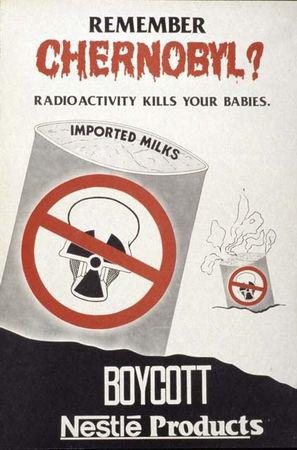
57 Remember Chernobyl?
Artist unknown Offset, Date Unknown
Place unknown
In April 1986, a sudden power surge at the Chernobyl Nuclear Power Plant in the former Soviet Union led to the worst nuclear fallout in history. At least 31 people were immediately killed; 115,000 local people were evacuated shortly after the accident, followed by another 220,000 people in subsequent years. The 18-mile area around the plant is still restricted today and may not be habitable for another 300 years.
Shortly after the accident, cows continued to graze on land that had been contaminated by the radioactive fallout, leading to the production of radioactive milk, cheese, butter, yogurt, and beef. Many local children drank milk contaminated with radioactive iodine, which released substantial doses to their thyroid glands. At least 6,000 of these children were later diagnosed with thyroid cancer.
In 1993, Nestlé Lanka was required to return 15 tons of milk powder that had been imported to Sri Lanka from Poland after local tests revealed high levels of radioactivity. These checks had become routine after the Chernobyl accident.
On the night of December 2, 1984, the Union Carbide pesticide plant in Bhopal, India began leaking 30 metric tons of methyl isocyanate and other poisonous gases into the air. All six safety systems designed to contain such a leak failed, allowing the gas to drift throughout Bhopal’s densely populated neighborhoods. About 600,000 people were exposed to the gases that night. Thousands died within days, and others suffered nausea and burning in the eyes and throat.
It is now believed that anywhere between 15,000 to 25,000 people died as a result of the horrific industrial accident; those who survived suffered respiratory problems, blindness, and other debilitating conditions. The ramifications continue today, as the toxic site was never properly cleaned up, and many of those who were exposed to the gas have given birth to children with physical and mental disabilities. In 2010, several former executives of Union Carbide Corporation (now Dow Chemical) were convicted of negligence in the disaster, and outrage over the corporate and government mishandling of the disaster continues today.

58 The Real Face of Globalisation Bhopal Group for Information and Action, Raghu Rai Offset, Circa 1994 India
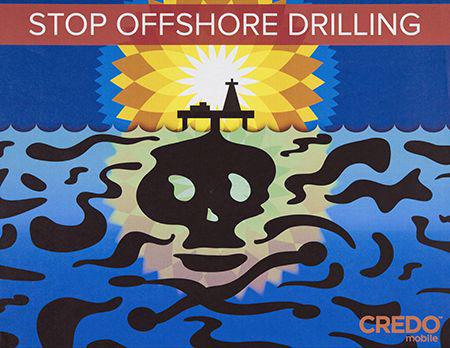
59 Stop Offshore Drilling
CREDO Mobile, Steven Lyons
Digital print, Circa 2010
Fairfax, CA
The Deepwater Horizon was an offshore oil drilling rig in the Gulf of Mexico leased by British Petroleum (BP). In 2010, the rig exploded, killing 11 workers and injuring 16. Shortly after, one of the rig’s pipes began leaking; before it could be stopped, over 4.9 million barrels of oil contaminated the ocean, making it the worst oil spill in U.S. history. The oil had devastating effects on marine life and marine ecosystems, and dolphins and sea turtles continue to die in record numbers. Many cleanup workers and coastal residents have also developed illnesses from exposure to large amounts of oil, including respiratory problems and skin conditions. Because much of the oil remains at the bottom of the ocean, the effects of the spill will continue to be felt for many years.
Fukushima, 2011
On March 11, 2011, a 9.0 magnitude earthquake hit Japan and triggered a tsunami that killed close to 19,000 people, shifted Japan’s main island by eight feet, and continues to cause fallout from the heavily damaged nuclear power plant in Fukushima. After the plant’s emergency power generators became flooded, three of six reactors exploded and leaked lethal amounts of radiation into the air and water. Hot molten fuel still lies in the three remaining reactors, which release around 100 tons of radioactive residual water every day. Although this contaminated water is stored in huge tanks around the power plant, the site is nearing its water storage capacity and many of the tanks are leaking. The Tokyo Electric Power Company (TEPCO) has been dumping the radioactive water into the Pacific Ocean. Today, the area surrounding the power has been turned into dumping grounds for millions of black bags containing radioactive waste cleared from nearby communities. The disaster has had negative effects on people all over the world, contaminating fish, water, and even the air we breathe.
This poster ties the 2011 nuclear disaster at Fukushima, Japan to the 1945 dropping of the atomic bomb on Hiroshima, Japan by way of reference to the 1959 French film Hiroshima Mon Amour. Both incidents represent major nuclear disasters in Japanese history characterized by loss of life and devastating environmental impact.

60 Fukushima Mon Amour
Fukushima My Love
Yossi Lemel
Offset, Circa 2011
Tel Aviv, Israel
In August 2005, Hurricane Katrina caused severe destruction along the Gulf coast from central Florida to Texas. It was one of the costliest and deadliest natural disasters in the history of the U.S. At least 1,836 people died in the hurricane and subsequent floods. Total property damage was estimated at $108 billion.
Southeast Louisiana and the Mississippi coast were especially hard it. Over fifty breaches in New Orleans’ hurricane surge protection caused the majority of the death and destruction. 80% of the city and large tracts of neighboring parishes became flooded, and the floodwaters lingered for weeks. At least 1,400 died directly due to levee failure. All of the major studies concluded that the U.S. Army Corps of Engineers, the designers and builders of the levee system was responsible, due to a decision to use shorter steel sheet pilings in an effort to save money.
In January 2008, the U.S. District Court, ruled that despite the corps role in the flooding, the agency could not be held financially liable. There was also an investigation of the responses from federal, state and local governments, resulting in the resignation of Federal Emergency Management Agency (FEMA) director Michael D. Brown, and of New Orleans Police Department (NOPD) Superintendent Eddie Compass. Many other government officials were criticized for their responses which ranged from inadequate to incompetent, especially New Orleans Mayor Ray Nagin, Louisiana Governor Kathleen Blanco, and President George W. Bush. Several agencies including the U.S.Coast
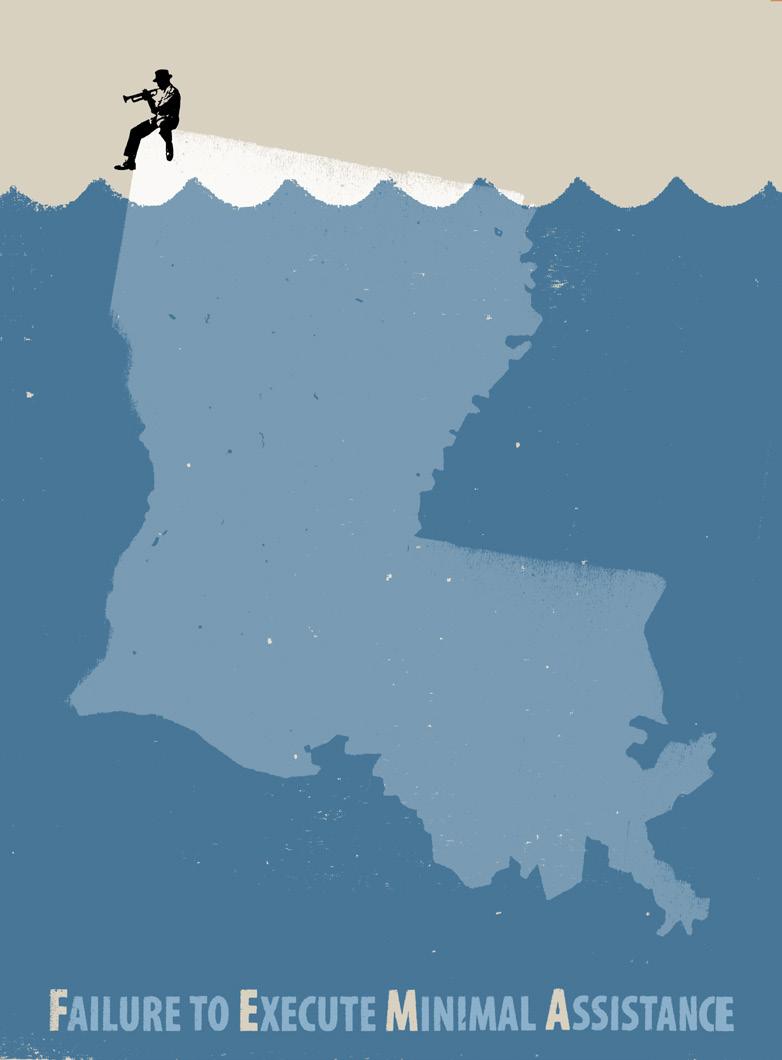
Guard, National Hurricane Center, and National Weather Service were commended for their actions. They provided accurate hurricane weather tracking forecasts with sufficient lead time to have evacuated the at risk populations. Unfortunately, the politicians didn’t act on these warnings. The title of this poster refers to the failure of FEMA to respond to the hurricane.
Two days after Hurricane Katrina hit New Orleans, Leif Steiner, creative director for Moxie Sozo, a Boulder, Colorado-based graphic designer, organized a group of international designers and artists to create The Hurricane Poster Project. Over 180 posters commemorating the event, including this one, were designed, produced and sold online, raising more than $50,000 donated to the Red Cross.
Scott Laserow, Zygo, The Hurricane Poster Project
Digital print, Circa 2005
Wyncote, Pennsylvania
Francisco Alves Mendes Filho, known as Chico Mendes, was a Brazilian rubber tapper, union leader and environmental activist. Rubber tapping, or the sustainable process of removing latex from rubber trees, has been practiced by families in the Amazon rainforest for generations. During the 1980s, Mendes fought for the rights of rubber tappers when cattle ranchers became interested in clearing rainforests and settling the land. Mendes opposed the destructive practices of large corporations and advocated for sustainable agricultural systems. Mendes played an important part in the foundation of the National Counsel of the Rubber Tappers and received the United Nations Environment Programme’s Global 500 award in 1987.
On December 22, 1988, Mendes was assassinated and became the 19th rural activist to be murdered that year in Brazil. More than thirty diverse organizations formed the Chico Mendes Committee to find and punish the landowner responsible for his death. In 1990, Darly and Darcy Alves da Silva were found guilty and convicted to 19 years in prison.

62 Chico Mendes 1944-1988
Doug Minkler Silkscreen, Circa 1989 Berkeley, CA

63 Karen Silkwood 1946-1974
Artist unknown
Offset, Date Unknown
United States
Karen Silkwood was a chemical technician at the Kerr-McGee’s plutonium fuels production plant in Oklahoma. She was also an activist—as a member of the Oil, Chemical, and Atomic Workers’ Union she was assigned to investigate health and safety issues at the plant. On November 13, 1974, Silkwood died in a mysterious one-car crash that has been the subject of great speculation.
During the week prior to her death, Silkwood was gathering evidence for the Union to support the claim that Kerr-McGee was negligent in maintaining plant safety. At the same time, she was involved in a number of unexplained exposures to plutonium. After her death, Silkwood’s family sued Kerr-McGee on behalf of her estate, and the jury found Kerr-McGee liable for Silkwood’s plutonium contamination.
Ken Saro-Wiwa
Ken Saro-Wiwa, poet, playwright, environmentalist, father, leader, fought for Nigeria’s Ogoni people in defense of their land and rights. Through The Movement for the Survival of the Ogoni People he challenged the power of the Royal Dutch/ Shell Co. and the military dictatorship. With his supporters he denounced the devastation of the Ogoniland by the oil companies and the military’s dirty war against the Ogoni. Saro-Wiwa and eight other Ogoni leaders were tried on trumped up charges before a military tribunal. They were hanged on November 10, 1995. In death as in life they continue to shake the foundations of the dictatorship. Their spirit lives on. The Ogoni nine: Baribor Bera · Saturday Dorbee · Nordu Eawu · Felix Nwate · Daniel Gbakoo · Barinem Kiobel · John Kpuniem · Ken Saro-Wiwa · Paul Levura.
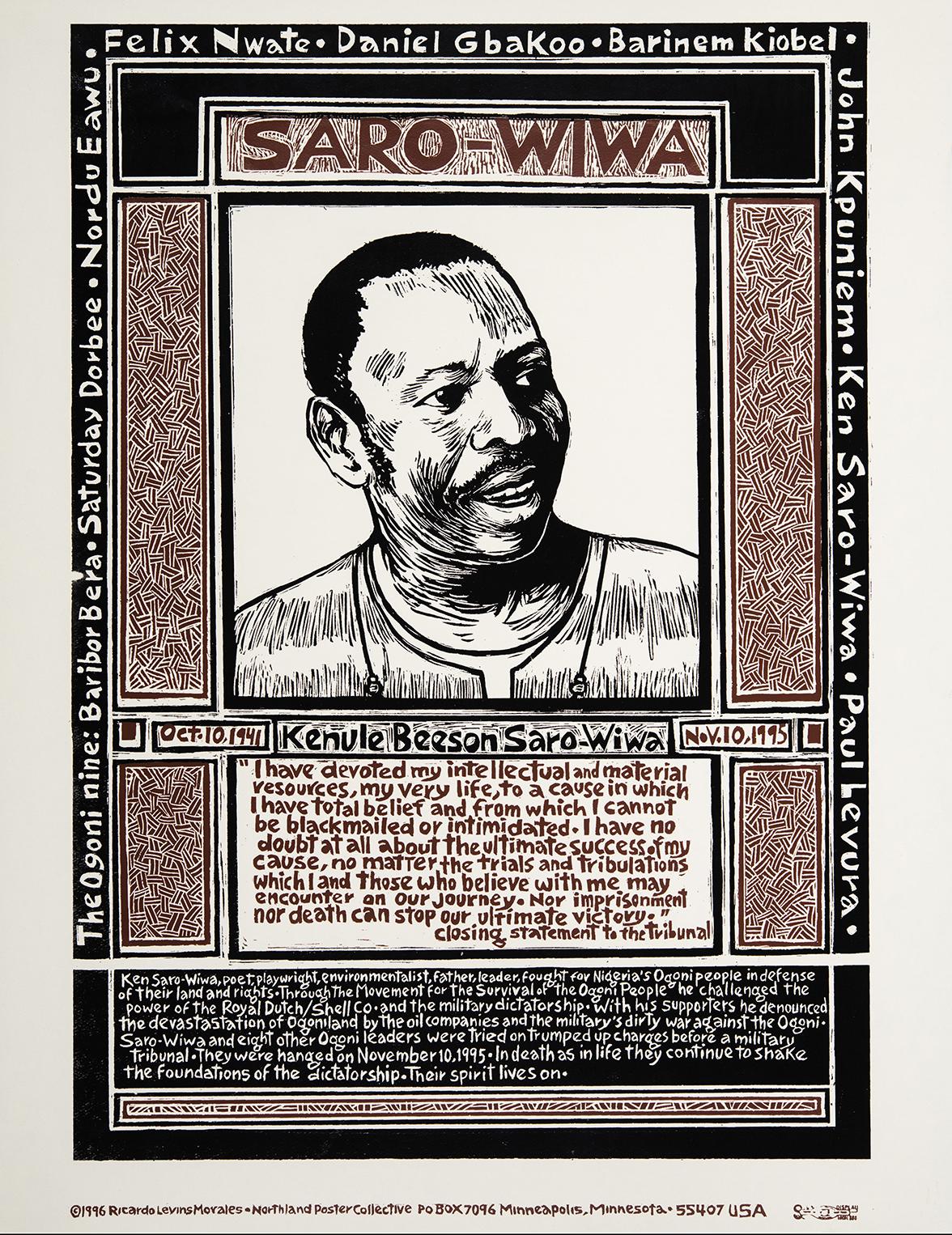

You can’t Sink a Rainbow
On July 10, 1985, agents of the French government bombed and sank the Greenpeace ship Rainbow Warrior in Auckland, New Zealand. Crewmember Fernando Pereira drowned as a result. The attack occurred just days before the Rainbow Warrior was to lead a Peace Flotilla of boats to Moruroa Atoll, where the government of France regularly explodes nuclear bombs as part of its weapons-testing program.
64 Ken Saro-Wiwa
Ricardo Levins Morales, Northland Poster Collective Silkscreen, Circa 1996 Minneapolis, MN
65 You Can’t Sink a Rainbow
Greenpeace Offset, Circa 1985 Country Unknown
Berta Cáceres was an indigenous environmental leader in Honduras who was assassinated in her home in March 2016. Her assassination occurred less than a year after Cáceres received the prestigious Goldman Environmental Prize, which is awarded to grassroots organizers working to protect the environment.
Cáceres had led a decade-long movement against a project to build the Agua Zarca Dam along the Gualcarque River. While international law requires that indigenous groups be consulted on projects affecting their land, the Lenca people did not give consent to the proposed building of the hydroelectric dam, which would threaten the group’s resources and livelihood. Cáceres was the 110th environmental activist to be killed in Honduras since the U.S. supported coup in 2009, which overthrew Manuel Zelaya, the democratically elected president.

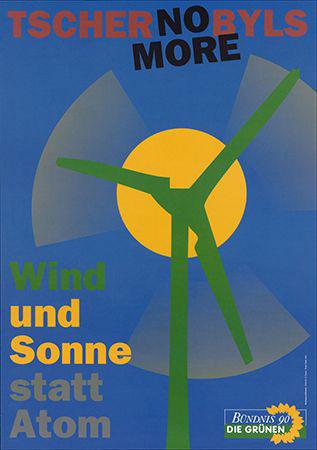
66 Berta Cáceres ¡Presente! Design Action Collective Offset, Circa 2016 Oakland, CA
67 No More Tschernobyls
Bündnis 90/Die Grünen Offset, Circa 1990s Cologne, Germany
John Running, Eric Kroll, Wizard & Genius, Leslie Barany Communications
Offset, Circa 1991 Zurich, Switzerland
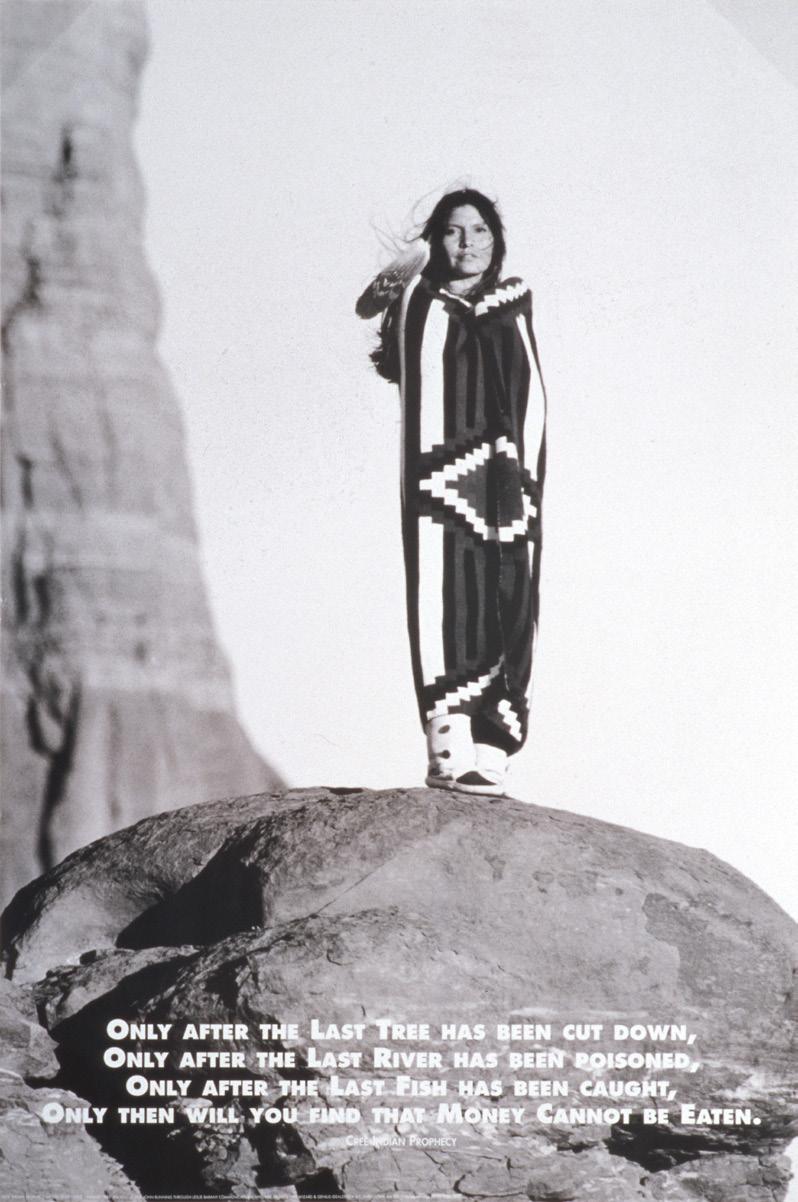
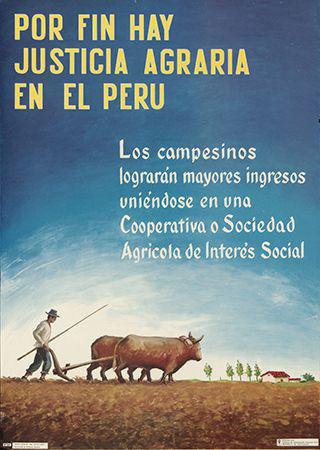
Finally there is agrarian justice in Peru
Javier López, Oficina de Información
Tecnica, Ministerio de Agricultura
Offset, Circa 1968-1978
Peru
A movement towards food sovereignty is being ignited by farmers, fishers, indigenous people and landless workers all over the world. According to the Declaration of Nyéléni, which was adopted by 80 countries at a global forum in 2007, food sovereignty puts control of food production and distribution in the hands of the people rather than with corporations. One of the goals of the movement is to reclaim the relationship between people and the land and emphasize the value of the laborers who grow, harvest, and process the world’s food.
Food sovereignty is a response to the current global approach towards food, which stresses efficiency and productivity. This approach prioritizes largescale, industrial farming that harms people and the environment. The food sovereignty movement seeks to ensure that the right to use and manage resources such as land, water, and biodiversity is held by the people.
70 Soberania Alimentaria Ya! Food Sovereignty Now! La Via Campesina Offset, Circa 2010 Mexico
71 Make a Difference 3 Times a Day Mahar Adjmi, EarthSave, Second Nature Graphics Offset, Circa 1990s Santa Cruz, CA

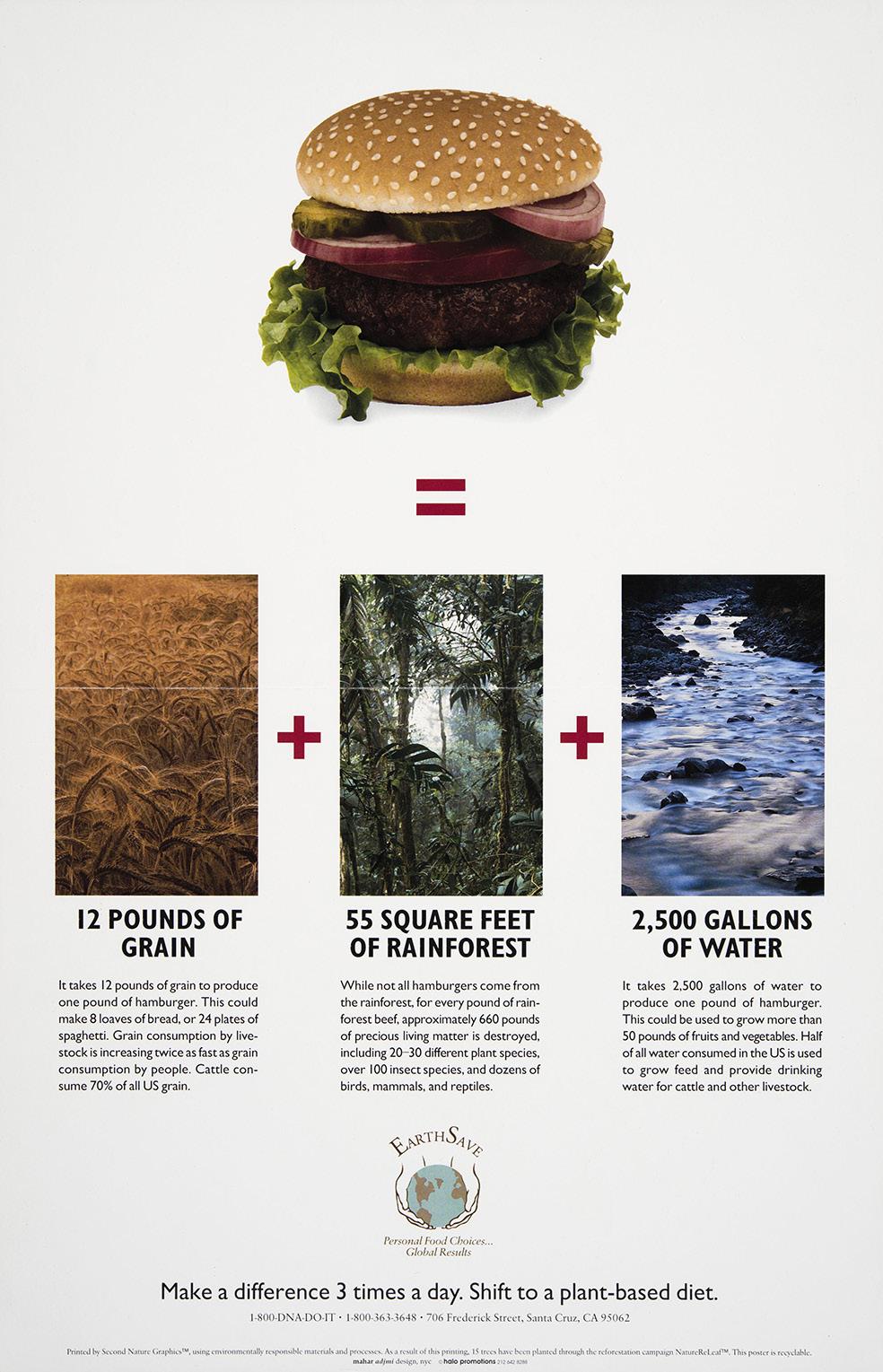

72 Green Jobs Now Design Action Collective Digital print, Circa 2008 Oakland, CA
73 People’s Climate March Sierra Club Offset, Circa 2014 California

The 2014 People’s Climate March held in New York City was the largest climate march in history, with over 400,000 people demanding action to end the climate crisis. The march coincided with a United Nations summit held in New York that week; organizers intended to show the world leaders attending the summit the power of the movement for environmental justice. That week, over 2,600 solidarity events were hosted in 162 countries.
74 No War! No Warming!
Design Action Collective, Grassroots
Global Justice Alliance
Photograph: Pablo Serrano
Offset, Date Unknown
Oakland, CA
75 When the Wealth of the Land is Shared by All Nosey Posters
Silkscreen, Circa 2003
Sydney, Australia


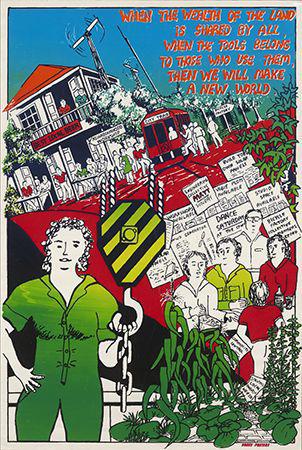
If You Give Me a Fish
Ricardo Levins Morales, Northland Poster Collective Silkscreen, Circa 1990s Minneapolis, MN 77 It Takes Roots to Weather the Storm
Micah Bazant, Grassroots Global Justice Alliance Digital print, Circa 2015
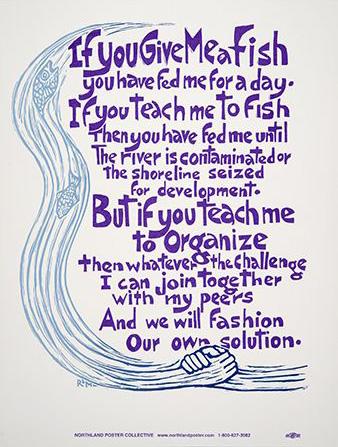


The 2015 United Nations Climate Change Conference, known as COP21, was held in Paris, France over the course of two weeks. The conference was the culmination of 20 years of United Nations negotiations between over 190 countries and aimed at achieving a universal and legally binding agreement to stop climate change. Many were disappointed when the conference ended without establishing any real and lasting commitment to a clean and sustainable world.
Communities of color and low-income communities are most impacted by the current climate crisis and are often at the forefront in the fight for environmental justice. It Takes Roots to Weather the Storm is a coalition of over 100 leaders and organizers from the U.S. and Canada’s grassroots and indigenous communities that attended the 2015 UN negotiations. The coalition acknowledges that COP21 did not bring us closer to a solution. Only a movement rooted in the power of the community can and must create a clean, green, and just world.
on Climate Change, Pollution & Environmental Justice was an extraordinary collaborative effort. First and foremost, we thank the artists, cultural workers, activists, and organizations who produced the posters; we thank everyone who saved the posters and donated them to CSPG so that future generations might learn from these powerful graphics.
ABCNT
Alison Alder
Jon-Paul Bail
Mariona Barkus
Micah Bazant
Cindy Bendat
Jim Brandenburg
Tom Butler
Robert Cenedella
Melanie Cervantes
Lincoln Cushing
Pam Debenham
Design Action Collective
Barry Deutsch
Earth Aware Editions
EarthShare
East Yard Communitiesfor Environmental Justice
Mark Epstein
Feminist MajorityFoundation
Grassroots
International
Robert Giusti
Greenpeace
Wendy Gutschow
Ted Hajjar
Nancy Halpern Ibrahim
Art Hazelwood
Inkworks Press Justseeds
David Kupfer
David Kunzle
Scott Laserow
La Via Campesina
Yossi Lemel
David Lester
Ricardo Levins Morales
Lighthawk
Steven Lyons
Josh MacPhee
Mazatl
Doug Minkler
Bill Moran
Northland Poster-
Collective
Nancy Ohanian
Jonathan Parfrey
Ann Pollon
Lenny Potash
Rainforest Action
Network
John Running Angelica Romero
U. G. Sato
Social Impact Studios
Chuck Sperry
Sierra Club
Taro Yamasaki
Peg Yorkin
Curatorial Committee:
Marie Kennedy
Yuki Kidokoro
Sandy Navarro
Sabina Virgo
Carol Wells

Interns & volunteers:
Ellen Hageman
Ted Hajjar
Susan Henry
Kate Kausch
Cheryl Revkin
Anibal Serrano
Tyler Simpson
2015 Getty interns: Samuel Camarena
Taylor Litonjua
Exibition Book Design:
2016 Getty Intern: Cynthia Viramontes